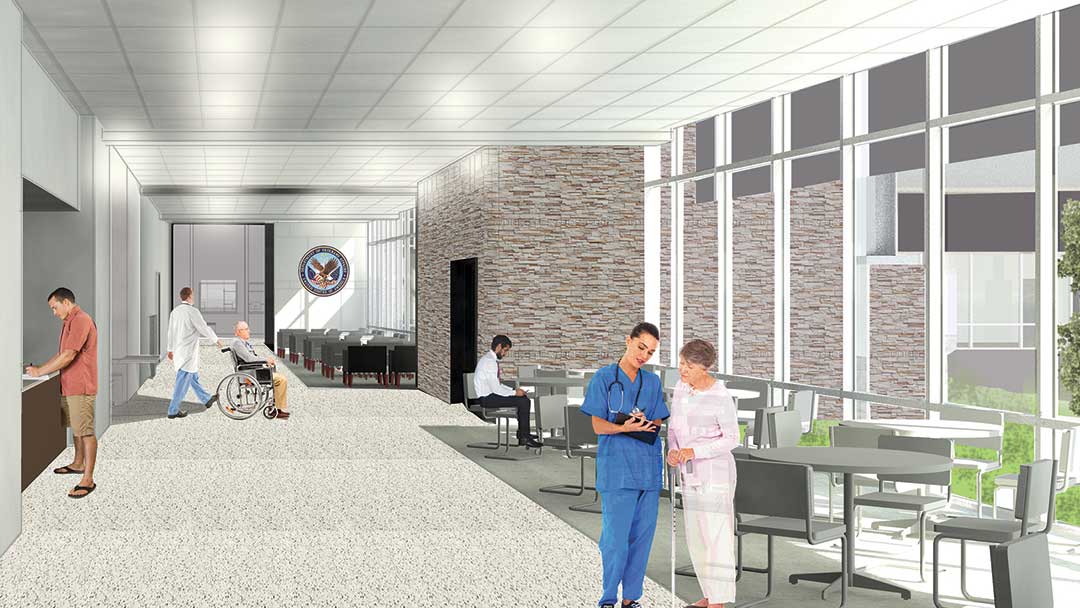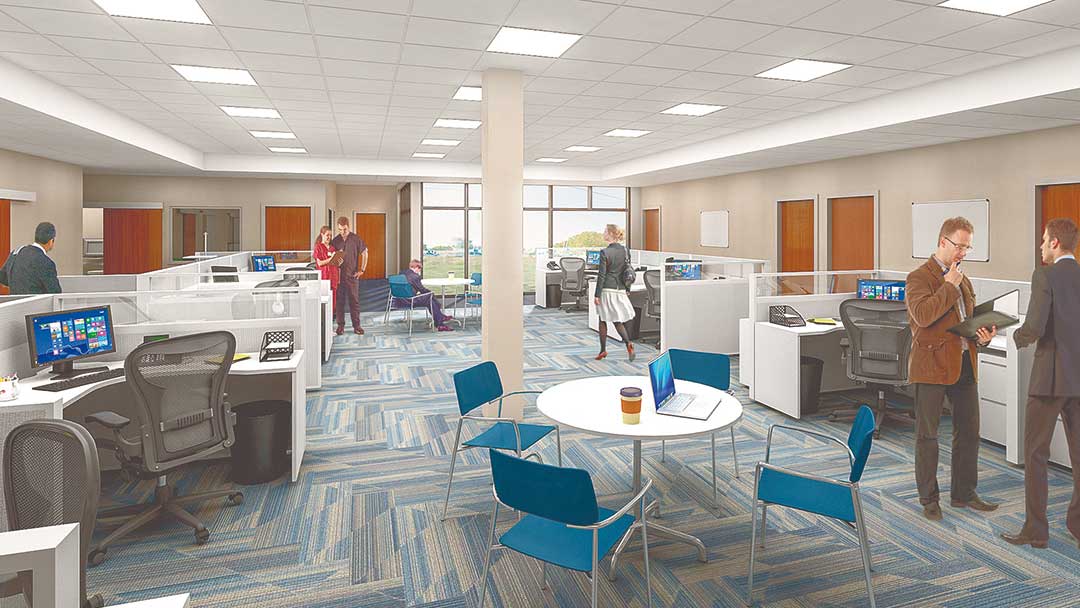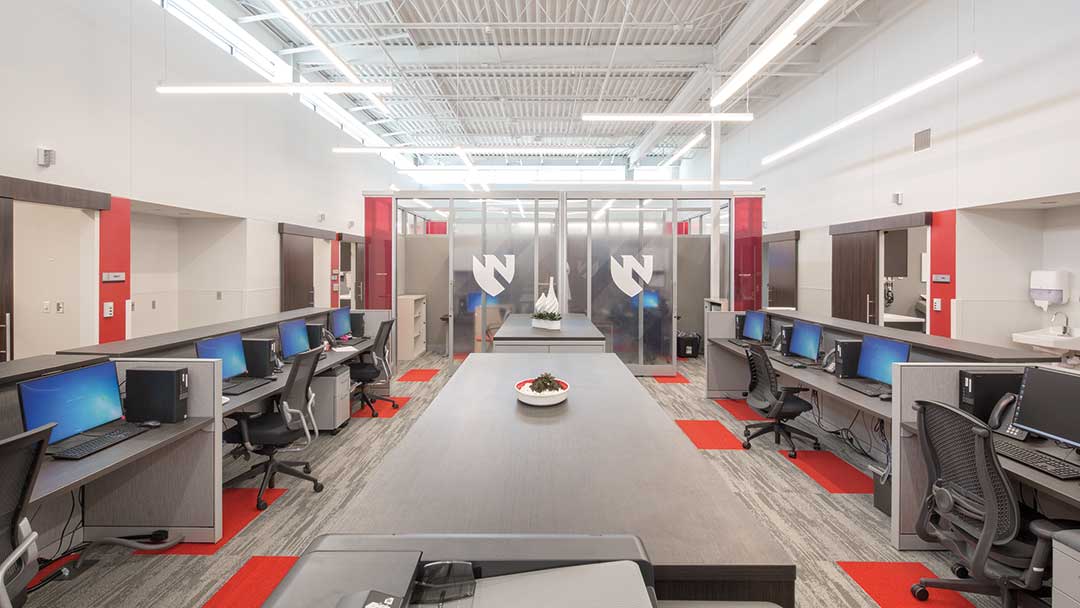Recent Articles
Patient-aligned care team model translates into private care
by Peter A. Yakowicz, National Director of Veterans Affairs Programs
The Veterans Health Administration (VHA) maintains a special focus on bringing services to the patient. After all, you would not expect a wheelchair-bound soldier returning from a war zone to maneuver the many floors and hallways of a hospital to receive healthcare.
So in 2014, VHA developed a prototype for its outpatient clinics based on its Patient-Aligned Care Team (PACT) model of care, which focuses on caring for the whole patient in one location. The design scheme enables physicians and clinical staff to work as a team, collaborating more efficiently across disciplines to make patient care decisions.
A typical PACT includes 10 dual-door exam and procedure rooms encircling a clinical work area, with available consult rooms as part of the overall PACT unit. The exam room includes a door for patients to enter from the corridor, along with a separate door on the opposite side for the provider to enter, directly off from the central internal team work zone area. This achieves a separation of patient and staff flow throughout the building, while minimizing steps for both major users of the facility.
PACT also provides a consistent design across clinics, in turn providing continuity in the patient experience, should he or she need to visit another location.
While the primary intent of the VHA’s PACT model is to center the care around the patient, co-locating the team work area also allows staff to provide high-quality care much more efficiently. This helps Veterans get the care they need more quickly and reduces the VHA’s access issues.
The VHA has been ahead of the curve in designing PACT facilities, creating a model of holistic care that has been replicated by the private sector. LEO A DALY has been honored to design 14 community-based outpatient clinics (CBOCs) and an ambulatory care center for the VHA using the PACT model, while also consulting as team members in the design of an additional 12 CBOCs.
Today, we are translating that PACT experience with the VHA into private sector facilities. Several private clinics designed in the past few years are now operational and are seeing the benefits of PACT.
The CHI Health Creighton University Medical Center Bergan Mercy Specialty Clinic in Omaha, Neb., which uses the PACT model, has been operational just over a year. Staff members who are experiencing this model for the first time say they like the separation of three streams of traffic: service, clinic staff and patient. They appreciate that patients experience the dignity of corridors dedicated specifically to them. They also appreciate that the collaboration space allows all staff to work together, in “zones” that are separated from the patients.
Nebraska Medicine is another client that is adopting PACT into its newest clinics throughout the Omaha metro area, with the first open about a year as well. To date, we have designed four PACT clinics for Nebraska Medicine.
Other private sector clients are interested in learning about the model and have toured PACT facilities we have designed. One clinic manager, who has worked in these spaces in the past, is an advocate of the model because of its ability to increase flexibility in exam rooms.
Standardizing Components
The PACT model also involves standardizing certain components of clinic design across facilities to provide a consistent experience and to increase operational efficiencies. These include the room size, column spacing and design of group therapy rooms. Nebraska Medicine is also adopting standardization with the site-adapt prototype design of its new clinics.
Room size
The standard room size in the VHA’s PACT clinics is 125 SF. It was determined to be the ideal size because it can serve as an exam room, office, consult room or other treatment room – what the VHA has dubbed a universal room. It allows the space to easily transition, either temporarily or more permanently, to another use as demographics change. If mental health outpatient treatment is increasing and other types of visits are decreasing, for example, the clinic can convert the room without the need to move walls.
Column spacing
Standard column spacing across facilities allows for consistency in construction and room sizing. When the VHA worked to develop the prototype, it started with the ideal layout of clinical space, and the result was a column grid of 31 feet, 10 inches by 31 feet, 10 inches. The grid fits into the layout of any given new space.
Group therapy rooms
Group therapy rooms – which are used for clinical group sessions, including mental health issues, weight management and more – generally have separate entrances and exits that can be used when the clinic is closed. They are designed so patients can enter from the lobby side and staff can come in from the clinic side. Clinic staff can secure the rest of the facility while patients are free to move into those spaces. This also allows sessions to be held after hours – while the rest of the clinic is closed, the VHA opens the lobby to group session attendees.
Learn About Our Healthcare Practice
Get to know our healthcare practice, people and portfolio by visiting our healthcare page.
 About the author
About the author
Pete is solely dedicated to the VA client and is guided by a personal dedication to the health and well-being of veterans in every aspect of his work. His unparalleled insight into the VA’s mission and challenges results from spending 33 years working with the VA, including the management of an $8 billion capital asset portfolio for 12 VA campuses and 68 community-based outpatient clinics. In 2005, Pete earned an award from the Department of Energy in recognition of VISN 23’s energy-saving and water-conservation efforts. He also earned several awards of recognition from the Secretary of the VA, including a 2010 award related to his work in response to the American Recovery and Reinvestment Act for helping stimulate the economy and creating jobs.Pete can be contacted at payakowicz@leoadaly.com or 612.341.9530




